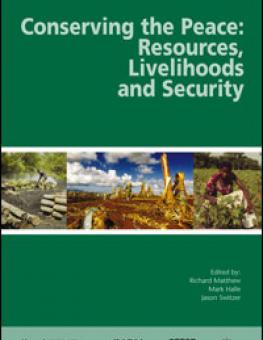
Conserving the Peace: Resources, Livelihoods and Security
In 2000, IISD and IUCN convened an international Task Force of leading experts to assess the linkages between environment and security and to begin converting what has largely been an academic debate into tools for conservation planning.
The Task Force subsequently commissioned a number of case studies from around the world that illustrate the linkages between environment and security.
Based on its research, the Task Force concluded that resource degradation and disaster largely affect the lives and livelihoods of the millions of poor around the world, especially those in indigenous and traditional communities. Loss of livelihoods, in turn, leads to social tension, migration and settlement in inappropriate areas, and often to conflict. It follows then that targeted investments in environmental conservation and the promotion of sustainable and equitable use of natural resources may be significant factors in mitigating disaster risk, reducing social tensions and avoiding costly conflicts.
The Task Force presented its results to the World Conservation Congress in 2000, to wide acclaim. The cases and their recommendations were published in 2002 as a book, launched at the World Summit on Sustainable Development in Johannesburg.
Publications
-
Environment and Security: Identifying IUCN's Role (PDF - 144 KB)
Outlines IUCN's interest and niche in the Environment and Security field, arguing that this thematic focus is closely linked to the Union's mission, and offers a new way of presenting conservation to a wider public. -
IUCN and Conflict Resolution: An Issues Briefing for the CEESP Task Force on Environment and Security (PDF - 107 KB)
Drawing from and expanding on the Gland Workshop Report and Discussion Paper (see above), this paper identifies some of the key issues and a range of options for IUCN to intervene in environment-related conflicts. -
Conserving the Peace: Resources, Livelihoods and Security (PDF - 2.7 MB)
This landmark publication lays out the issues in clear terms and describes how better natural resources management can be a cost-effective investment in human security, and what tools are needed for ensuring it does so.
Table of Contents
-
Introduction (PDF - 344 KB)
Richard Matthew, University of California-Irvine, Mark Halle and Jason Switzer, IISD -
Overview A: Biodiversity, Conflict and Tropical Forests (PDF - 339 KB)
Jeffrey A. McNeely, IUCN-The World Conservation Union -
People, Scarcity and Violence in Pakistan (PDF - 459 KB)
Richard Matthew, University of California-Irvine, Asif Ali Zaidi, IUCN Pakistan -
Forests, Fires and Confrontation in Indonesia (PDF - 336 KB)
Charles Victor Barber, International Marinelife Alliance -
Resources, Abundance and Competition in the Bosawas Biosphere Reserve, Nicaragua (PDF - 258 KB)
David Kaimowitz, Center for International Forestry Research -
Natural Resource Scarcity and Violence in Rwanda (PDF - 328 KB)
James Gasana, Intercooperation -
Colonialism and Inequity in Zimbabwe (PDF - 358 KB)
Ryan Hill and Yemi Katerere, IUCN Regional Office for Southern Africa -
Overview B: Environmental Degradation and Regional Vulnerability: Lessons from Hurricane Mitch (PDF - 441 KB)
Pascal O. Girot, University of Costa Rica -
Turbot and Tempers in the North Atlantic (PDF - 319 KB)
Elizabeth R. DeSombre, Wellesley College, J. Samuel Barkin, University of Florida -
Overview C: Conservation in Times of War (PDF - 283 KB)
Judy Oglethorpe, Rebecca Ham, James Shambaugh and Harry van der Linde, Biodiversity Support Programme -
Conclusion (PDF - 303 KB)
Mark Halle, Richard Matthew and Jason Switzer, IISD
Participating experts
You might also be interested in
Protected areas and the security community
Protected Areas are often situated in remote areas prone to conflict, but they can also make important contributions to peace. This paper draws from IISD's contribution to the World Parks Congress (September 2003, Durban), highlighting the different ways in which Protected Areas are linked to conflict and what this means for different members of the 'security community.'
Conserving Biological Hotspots in Conflict-Affected Democratic Republic of Congo
Maiko National Park, in the eastern part of the Democratic Republic of Congo, is so remote that the park’s northern edge can only be reached by a seven-day walk through thick, inhospitable forest.
CSC Stories: Restoring the Lake Edward Fishery in Virunga National Park
A short profile of efforts by IISD and the Wildlife Conservation Society to address the impacts of conflict on the Lake Edward fishery in Virunga National Park in the eastern Democratic Republic of Congo.
CSC Stories: Developing Conflict-Sensitive Management Strategies in Public-Private Conservation Concession in the Amazon
A short profile of efforts to reduce social conflicts around the Los Amigos Conservation Concession in the Peruvian Amazon by incorporating the conflict-sensitive conservation approach into conservation planning and strategies.